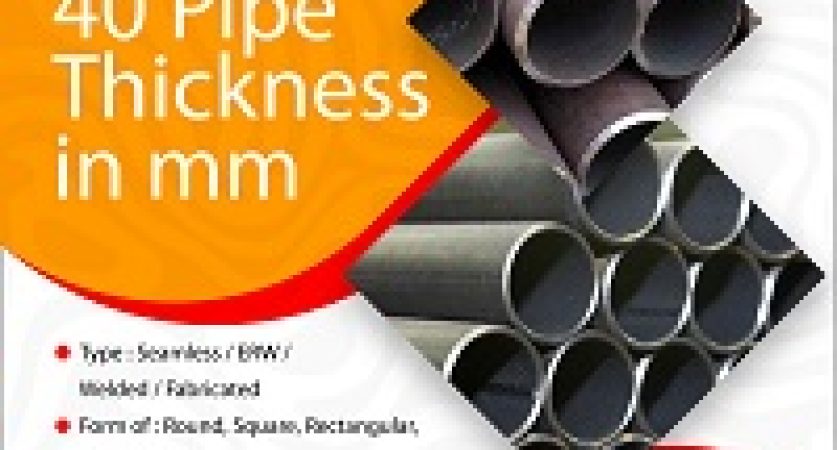Understanding ISMC Weight Chart and Schedule 40 Pipe Thickness in mm

When dealing with construction, manufacturing, or engineering projects, having accurate information on materials is crucial. Two essential pieces of information are the ISMC weight chart and Schedule 40 pipe thickness in mm. This guide will delve into what these terms mean, their importance, and how to use them effectively in your projects.
What is the ISMC Weight Chart?
ISMC stands for Indian Standard Medium Channel, a type of steel channel commonly used in construction and structural applications. The ISMC weight chart is a comprehensive table that lists various dimensions and corresponding weights of ISMC channels. Understanding this chart is critical for engineers, architects, and builders because it helps in selecting the right size and weight of steel channels for specific applications.
Why is the ISMC Weight Chart Important?
The ISMC weight chart is important for several reasons:
- Structural Integrity: Knowing the weight and dimensions of ISMC channels ensures that the structures built are safe and sound. It helps in calculating the load-bearing capacity and ensuring that the channels used can support the required loads.
- Cost Estimation: Accurate weight calculations help in budgeting and cost estimation. By knowing the weight of the materials needed, one can estimate transportation costs and overall project costs more accurately.
- Material Selection: The weight chart aids in selecting the right material for specific applications. Different projects require different channel sizes and weights, and the chart provides all the necessary information to make an informed decision.
How to Use the ISMC Weight Chart
Using the ISMC weight chart is straightforward. The chart typically includes the following information:
- Designation: The size of the ISMC channel (e.g., ISMC 75, ISMC 100).
- Depth of Section (mm): The height of the channel.
- Width of Flange (mm): The width of the horizontal part of the channel.
- Thickness of Web (mm): The thickness of the vertical part of the channel.
- Weight per Meter (kg/m): The weight of the channel per meter length.
To use the chart, identify the ISMC designation you need based on your project requirements. Then, look up the weight per meter and other dimensions. This information will help you determine how much material you need and ensure you select the right size for structural integrity.
Example of an ISMC Weight Chart
Here is a simplified example of an ISMC weight chart:
What is Schedule 40 Pipe Thickness in mm?
Schedule 40 is a standard that indicates the wall thickness of a pipe. Pipes come in different schedules, and Schedule 40 is one of the most commonly used standards in various industries. The thickness of a Schedule 40 pipe is determined by the pipe’s nominal size and the schedule number, which represents the wall thickness.
Importance of Knowing Schedule 40 Pipe Thickness in mm
Knowing the Schedule 40 pipe thickness in mm is essential for several reasons:
- Pressure Handling: The thickness of the pipe wall determines how much pressure the pipe can handle. For applications involving high-pressure fluids, selecting the correct pipe thickness is crucial to avoid failures and leaks.
- Flow Capacity: The wall thickness affects the internal diameter of the pipe, which in turn affects the flow capacity. Understanding the pipe thickness helps in designing systems with adequate flow rates.
- Compatibility: When integrating pipes into existing systems, knowing the exact thickness ensures compatibility with other components such as fittings, flanges, and valves.
How to Determine Schedule 40 Pipe Thickness in mm
The thickness of Schedule 40 pipes can be found in standard pipe dimension tables. These tables list the nominal pipe size and the corresponding wall thickness for different schedules. Here’s how to read the table:
- Nominal Pipe Size (NPS): This is the diameter of the pipe.
- Schedule Number: Indicates the wall thickness.
- Wall Thickness (mm): The actual thickness of the pipe wall in millimeters.
Example of Schedule 40 Pipe Thickness in mm
Below is a simplified table showing the Schedule 40 pipe thickness in mm for various nominal pipe sizes:
Using ISMC Weight Chart and Schedule 40 Pipe Thickness Together
In many construction and engineering projects, both ISMC channels and Schedule 40 pipes are used. Here’s how to use these charts together effectively:
- Planning and Design: During the planning phase, determine the load-bearing requirements and fluid handling needs of your project. Use the ISMC weight chart to select the appropriate steel channels for structural support. Simultaneously, use the Schedule 40 Pipe thickness in mm chart to choose pipes that can handle the required pressure and flow rates.
- Material Procurement: Accurate knowledge of ISMC weights and pipe thicknesses ensures you order the right materials. This precision reduces wastage and ensures you have the necessary materials on-site.
- Construction and Assembly: During the construction phase, follow the dimensions and weights specified in the charts to ensure proper assembly. This practice guarantees that the structure will meet safety standards and perform as expected.
- Quality Control: Regularly refer to the charts during quality control checks. Verifying that the correct materials are used at every stage helps in maintaining the integrity and safety of the project.
Practical Applications of ISMC Weight Chart and Schedule 40 Pipe Thickness
Building Construction
In building construction, ISMC channels are often used for framing and support structures. The ISMC weight chart helps in selecting channels that can bear the load of floors, roofs, and walls. Schedule 40 pipes are used for plumbing, heating, and gas lines. Knowing the pipe thickness ensures that the plumbing system can handle the pressure of water and gas safely.
Industrial Manufacturing
In industrial settings, ISMC channels are used to construct frameworks for machinery and equipment. The weight chart ensures the channels can support heavy machinery without bending or breaking. Schedule 40 pipes are used in various processes, including the transport of chemicals and gases. The pipe thickness chart ensures these pipes can withstand internal pressures without failing.
Infrastructure Projects
In infrastructure projects like bridges and highways, ISMC channels are used in the construction of girders and supports. The ISMC weight chart helps in choosing the right size and weight for these critical components. Schedule 40 pipes are used for drainage and sewage systems. Knowing the exact pipe thickness ensures these systems can handle large volumes of water and waste.
Conclusion
Understanding the ISMC weight chart and Schedule 40 pipe thickness in mm is essential for anyone involved in construction, manufacturing, or engineering. These charts provide vital information that ensures structural integrity, safety, and cost efficiency. By using these charts effectively, you can make informed decisions, procure the right materials, and ensure the success of your projects. Whether you’re building a skyscraper, manufacturing heavy machinery, or constructing infrastructure, these tools are indispensable for achieving precision and excellence.
- SHARES
- [shared_counts]

Ashmawi Sami has a Bachelor degree in Travel and Tourism Management from the University of Minnesota. He has his own travel vlogging channel. Besides being a fantastic yoga instructor he has travelled to 9 countries and planning his next trip soon. As the father of 3 dogs, he is well-trained in parenting, crowd control, and crisis situations.
ABOUT ME

Gillian is a freelance blogger, student, and full-time traveler. Each day she spends her time exploring something exciting to help people find the information they need while travelling to a new destination. Whether it be the place to enjoy holidays, or a spot to throw a party or hidden gems that you must visit in the city.
ALL CATEGORIES
- Adventure (13)
- Automotive (8)
- Business (725)
- Education (13)
- Event (4)
- Health (286)
- Insurance (11)
- Lifestyle (12)
- News (1)
- Real Estate (19)
- Shopping (26)
- Technology (23)
- Travel (8)

JOIN US TODAY
POPULAR POST
January 27, 2021 -
Adventure Travel For The Audacious Spirit
January 27, 2021 -
Small Business Loans for Women
January 27, 2021 -
Adventure Tours in Vanuatu
RECENT POST
July 12, 2025 -
How Does the Braided Wig Combine Style and Convenience?
In the evolving world of hair fashion, braided...
July 10, 2025 -
Precision Engineered Fasteners: Trusted Manufacturers in India
India has firmly established its recognition as a...
July 10, 2025 -
Premium Super Duplex, Titanium and Copper Nickel Products for Industrial Excellence
As worldwide industries evolve, the call for superior...
July 10, 2025 -
Top copper product manufacturer in India: Quality you can trust
Copper is one of the maximum critical metals...








